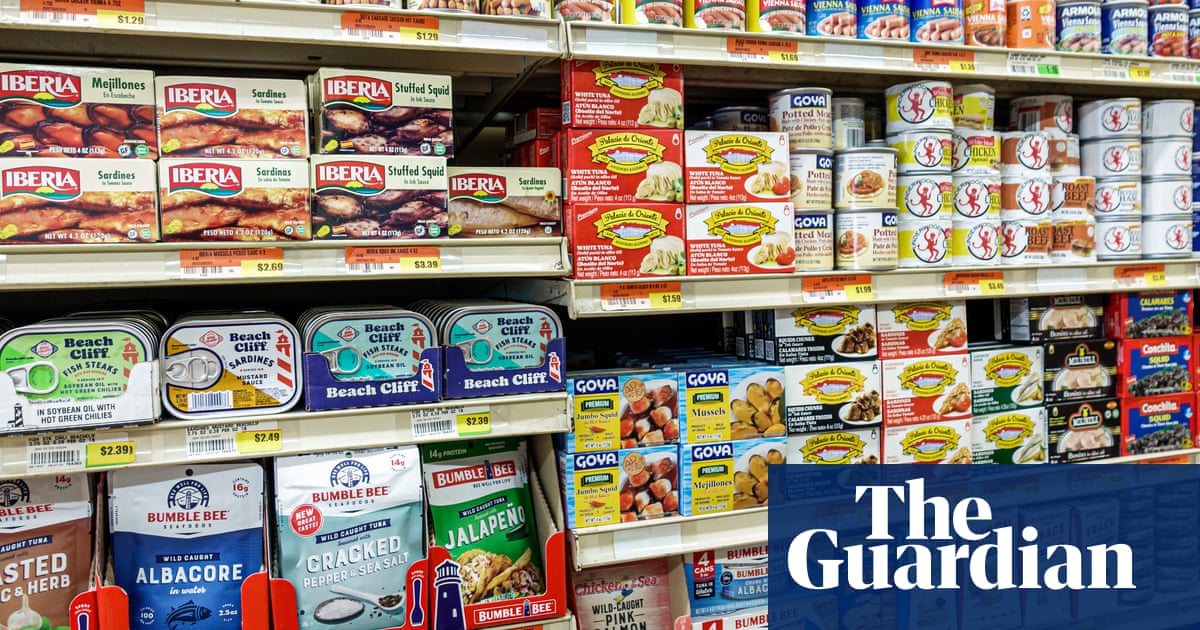Canned foods make up a big part of 20-year-old Cale Johnson’s diet: tuna, corned beef hash, beans, chicken soup, Spam and fruit. They’re affordable and have a long shelf life, which is essential for many people in the US like Johnson, who earns a low income and works two part-time jobs in addition to being a full-time student in Omaha,Nebraska.
In the days after Donald Trump’srecent decisionto double tariffs on steel and aluminum, Johnson says he’s worried.
“I know that some people have been resorting to stocking up only on non-perishable goods now before they get more expensive,” said Johnson, who has used the Supplemental Nutrition Assistance Program (Snap) to make ends meet. “There’s a feeling of panic and having to prepare in the coming months.”
One of Trump’s key campaign promises was to lowergrocery costsfor consumers who have had to contend with pandemic supply chain issues, rising food prices and inflation in recent years. But his new steel and aluminum tariffs, which took effect on4 June, threaten to do just the opposite. The new 50% tariff rate could raise food prices in a matter of months, industry trade groups and supply chain experts warn.
Tariffs on canned goods, which could raise prices for items in steel cans byup to 15%, would create what some anti-hunger experts are calling a “double-whammy” for people using Snap, now that the program isfacing the biggest cuts in history. The Republican House budget bill, which passed in the House and is now under review in the Senate, would slash Snap, which is considered the US’s most effective tool in fighting hunger, taking food off the table for millions of Americans – including 2 million children – at a time when the cost of key staples is set to grow.
“As grocery prices continue to rise and Snap benefits are reduced, families across the country will be left with fewer resources to meet even their basic needs,” said Gina Plata-Nino, Snap’s deputy director at theFoodResearch & Action Center (Frac). “We are likely to see a rise in food insecurity, housing instability and homelessness as more individuals and families are forced to make impossible choices between paying for food, rent, transportation, and other essentials.”
The current average Snap benefit is only about $6 a day per person.
Parke Wilde, a food economist at Tufts University who studies food security, hunger and the economics of food assistance programs such as Snap, agreed that hunger could “worsen substantially” over the next two years as a result of these policies. “This is a sharp retrenchment in the strength of the hunger safety net,” he said.
If Snap cuts are signed into law and metal tariffs are not overturned or exempted for food production, more pressure will also be placed on hunger relief organizations and food banks.
“Non-perishables, including canned goods, are always part of our strategy because of their long shelf life and versatility,” said Michelle Orge, executive director of Second Harvest Foodbank of Southern Wisconsin. “Increased costs of canned goods will affect our ability to procure the amount that we have planned for and that our partners and neighbors are relying on. We will either buy less or we will buy less variety if we find a good price on certain items, but not others.
“Increased costs from tariffs could also potentially affect non-perishable food donations since the cost of those items will be higher and folks may be less likely to donate them,” she said.
The Can Manufacturers Institute, an industry trade group,saysthe latest tariffs would inflate canned food prices and give foreign canned food producers in Asia, including China, a chance to “undercut” US farmers and food producers.
“The tariffs are a food security issue,” said Scott Breen, president of CMI. “We want to be able to manufacture cans here and fill them with food grown in the US. The tariffs create an unnecessary cost that someone has to bear: the can maker, the retailer, the brand and the consumer.”
American can makers import nearly 80% of tin mill steel, the type used for products such as canned beans, tuna, chicken broth and tomato paste, a result of the cut in domestic production after the 2018 tariffs on tin mill steel during Trump’s first term. Since then, American steelmakers have shut down nine tin mill lines with only three domestic production lines remaining.
CEOs from companies such as Del Monte, Goya Foods, Bush’s Beans and Hormel Foods have alreadycalled onTrump for targeted tariff relief on tin mill steel and aluminum produced by allies such as Canada before the tariff was doubled from 25% to 50%, however it is unclear if an exemption will be granted.
The Aluminum Association, which represents companies that make most of the aluminum and aluminum products shipped in North America, said in a recentstatementthat the tariff of 50% “threatens to undermine the very industry the administration aims to support”.
Although Trump says he is attempting to revive US manufacturing with his tariffs, rising grocery prices would be part of a ripple effect that could raise costs across various industries.
In the end, it’s regular people who will pay the price.
“Food insecurity is not going away … and people’s food prices are not going down,” said Frac’s Plata-Nino. “GOP policymakers haven’t thought about those things because the lived reality of average Americans is very different from those who live in wealthy places.”
